› Forums › Variable Stars › SN 2021hpr
- This topic has 14 replies, 7 voices, and was last updated 4 years, 8 months ago by
 Mike Harlow.
Mike Harlow.
-
AuthorPosts
-
4 April 2021 at 6:50 pm #574936
 Jeremy ShearsParticipant
Jeremy ShearsParticipantRon Arbour has asked me to post some details about this newly discovered SN and his image taken last night (2021 Apr 3).
This was discovered object by Itagaki on 2021 Apr 2.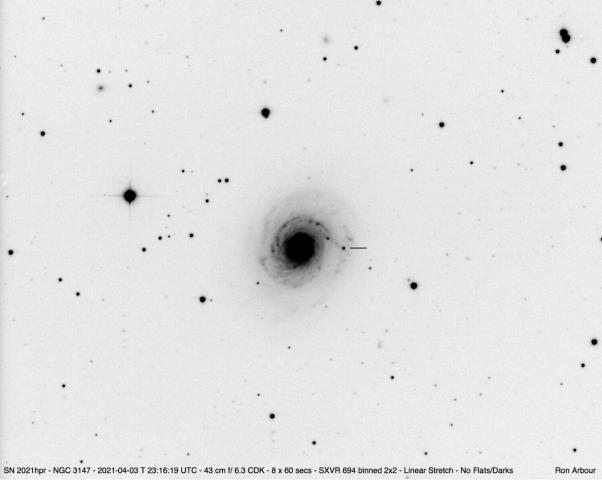 The Padova-Asiago group describe this young SN as follows :-“The spectrum shows several broad features reminiscent of the early spectra of Ic-BL supernovae.A broad absorption centred at about 591.0 nm (rest frame) can be identified with SiII 635.5 nm and then an expansion velocity of about 21000 km/s is estimated. However, this feature appears much stronger that in typical Ic spectrum and more consistent with the SiII feature in SN Ia. At this stage, the classification remains uncertain.”
The Padova-Asiago group describe this young SN as follows :-“The spectrum shows several broad features reminiscent of the early spectra of Ic-BL supernovae.A broad absorption centred at about 591.0 nm (rest frame) can be identified with SiII 635.5 nm and then an expansion velocity of about 21000 km/s is estimated. However, this feature appears much stronger that in typical Ic spectrum and more consistent with the SiII feature in SN Ia. At this stage, the classification remains uncertain.”Attachments:
4 April 2021 at 9:11 pm #584051 Robin LeadbeaterParticipant
Robin LeadbeaterParticipantAt ~mag 17 last night this was near my limiting magnitude for spectra but the strong features confirm a type Ia so it should get a fair bit brighter yet. Here is my spectrum compared with a match from SNID
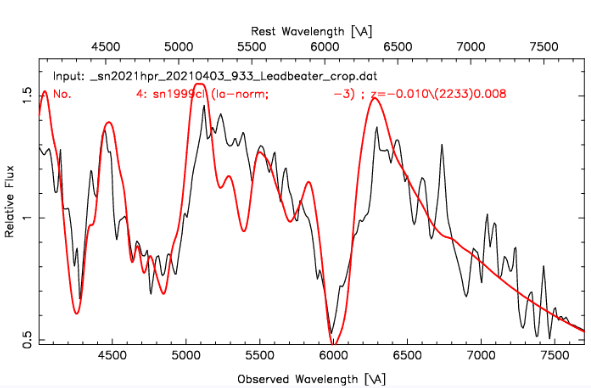
and my spectrograph guider image
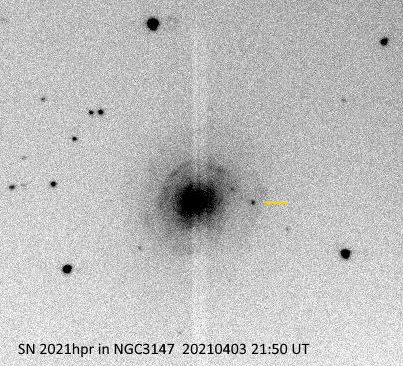 4 April 2021 at 9:26 pm #584050
4 April 2021 at 9:26 pm #584050 Robin LeadbeaterParticipant
Robin LeadbeaterParticipantThe Padova-Asiago classification in TNS was type I (uncertain – either Ic-BL or Ia). This has now been revised to type Ia based on a spectrum from ZTF (LT/SPRAT)
https://www.wis-tns.org/object/2021hpr
I am just reducing my spectrum taken last night.
Cheers
Robin
8 April 2021 at 12:32 pm #584062 Robin LeadbeaterParticipant
Robin LeadbeaterParticipantI’ve just realised this is the second supernova in this galaxy this year. SN 2021do (type Ic) reached mag 16.5 mid January but is now down to mag 20
https://alerce.online/object/ZTF21aaaubig
Cheers
Robin
8 April 2021 at 2:15 pm #584063 Robin LeadbeaterParticipant
Robin LeadbeaterParticipantI see Ivan Walton caught SN2021hpr on the night of 2nd April 14 hours after discovery in this member’s image
crop below
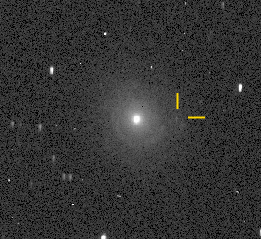 9 April 2021 at 1:10 pm #584065
9 April 2021 at 1:10 pm #584065 Stewart John BeanParticipant
Stewart John BeanParticipant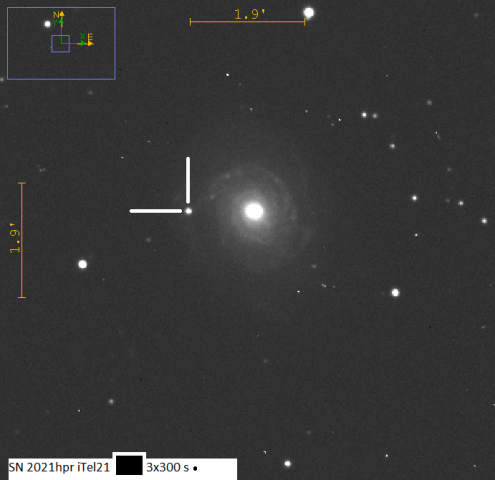
This is an image from 2021-04-09 09:00:20 obtained from New Mexico using iTel 021. 3 x 300 s exposure in V filter.
10 April 2021 at 8:25 am #584078 Stewart John BeanParticipant
Stewart John BeanParticipantVphot estimates the SN to be at V mag 14.85
10 April 2021 at 11:31 pm #584083 David SwanParticipant
David SwanParticipantThis SN is in a lovely host galaxy. Picture taken 10 Apr.
11 April 2021 at 10:18 am #584085 Maxim UsatovParticipant
Maxim UsatovParticipantMeasured it at V = 14.665 ± 0.04.
Telescope 0.43-m f/6.8 reflector with f/4.5 focal reducer
Camera FLI PL6303E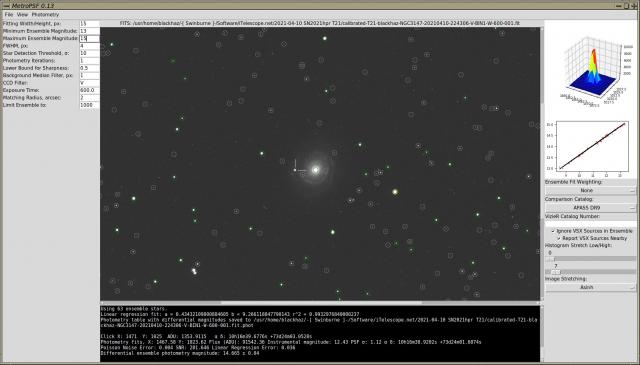 13 April 2021 at 2:05 pm #584090
13 April 2021 at 2:05 pm #584090 Robin LeadbeaterParticipant
Robin LeadbeaterParticipantIt looks like it is now close to maximum.
https://alerce.online/object/ZTF21aarqkes
At a distance of 40Mpc (from NED) an apparent magnitude of 14.6 gives an absolute mag of -18.4 not allowing for any extinction
An ALPY200 spectrum from last night continues to give a good match to a type Ia at the host redshift
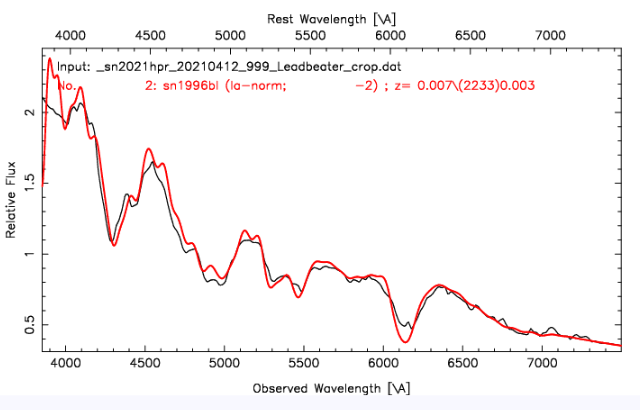
Cheers
Robin
18 April 2021 at 2:04 pm #584101 David StrangeParticipant
David StrangeParticipant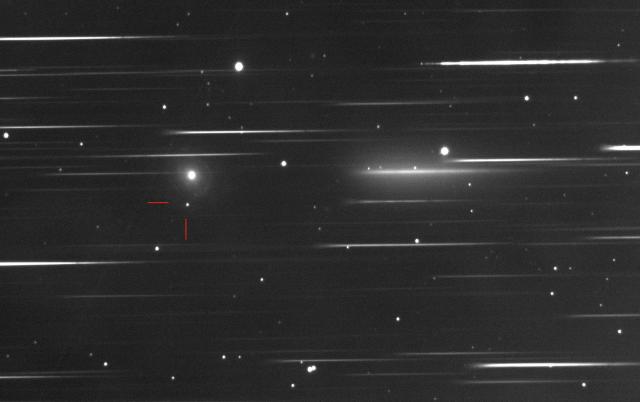 Caught this spectrum of SN2021hpr last night. It’s a 20 x120s stack with a Star Analyser 100, C9 and ASI183MM, but only problem was my calibration using the bright A0V star Izar looked oversaturated and I couldn’t get a useful calibration for one point alignment. Does the SN spectrum look about right?
Caught this spectrum of SN2021hpr last night. It’s a 20 x120s stack with a Star Analyser 100, C9 and ASI183MM, but only problem was my calibration using the bright A0V star Izar looked oversaturated and I couldn’t get a useful calibration for one point alignment. Does the SN spectrum look about right?David
18 April 2021 at 4:18 pm #584102 Robin LeadbeaterParticipant
Robin LeadbeaterParticipantHi David,
All is not lost. There is a field star showing a nice telluric absorption band at ~7620A which you can use to get an approximate wavelength calibration. (~25A/pixel off the posted image but that may have been reduced down from the original)
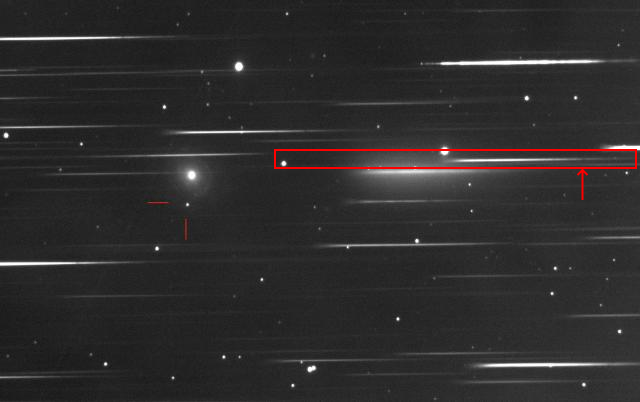
Robin
18 April 2021 at 4:50 pm #584103 Robin LeadbeaterParticipant
Robin LeadbeaterParticipantThat would make this deep absorption the characteristic Si II line
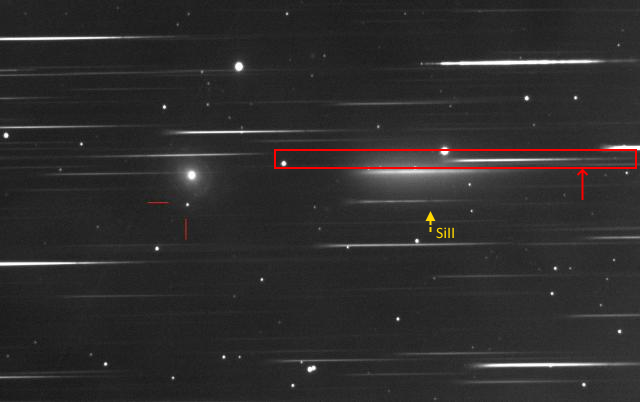 18 April 2021 at 6:42 pm #584104
18 April 2021 at 6:42 pm #584104 David StrangeParticipant
David StrangeParticipantThanks very much Robin for your thinking outside the box! That never occurred to me!
Cheers
David
19 April 2021 at 9:16 pm #584106 Mike HarlowSpectator
Mike HarlowSpectatorI’ve attached my recent objective prism spectrum not because it shows anything new but to illustrate a trick used for line identification. (Taken on 12th April 2021).
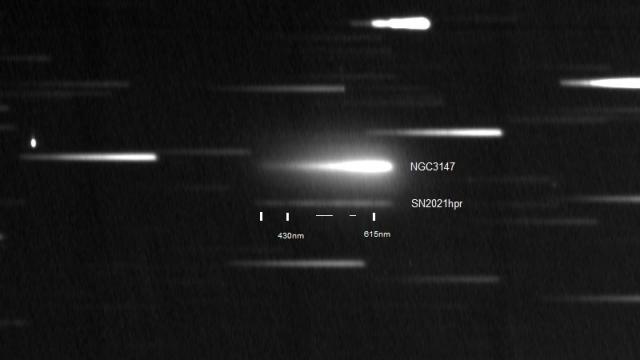
I usually image and take spectra through an Astrodon luminance filter which has a sharp cut-off at 700nm. The result is that all spectra cut-off at that wavelength giving an internal reference on all the spectra in the field. Coupled with the dispersion equation for the prism this enables reasonable estimates for line positions. In the spectrum of SN2021hpr the first absorption below 700nm is the Si II line as shown nicely in Kevin Gurney’s spectrum (of another type-Ia SN) and those above.
I can’t claim any originality here, this was a trick used by professional astronomers conducting objective prism surveys in the 1960s, 70s and 80s. Some of the photographic plates used had sharp spectral cut-offs imprinting a known wavelength on their spectra. And when you have a Schmidt photographic plate with 1000s of spectra on it that’s really useful!
-
AuthorPosts
- You must be logged in to reply to this topic.
